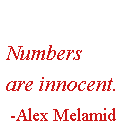
Dia's second artists' project for the world wide web, begun in 1995, was created by the Russian emigrant artist team Vitaly Komar and Alex Melamid. The Most Wanted paintings, as well as the Least Wanted paintings, reflect the artists' interpretation of a professional market research survey about aesthetic preferences and taste in painting. Intending to discover what a true "people's art" would look like, the artists, with the support of the Nation Institute, hired Marttila & Kiley, Inc. to conduct the first poll. In 1994, they began the process which resulted in America's Most Wanted and America's Least Wanted paintings, which were exhibited in New York at the Alternative Museum under the title "People's Choice."Under Dia's auspices, and with the sponsorship of Chase Manhattan Bank, the artists expanded their market research to more than a dozen countries around the globe and in turn, created Most Wanted and Least Wanted paintings for each country. Digitized versions of the paintings and the survey statistics which inform them are made available to the public through Dia's web site. In addition, visitors to Komar and Melamid's web page were invited to take the market survey questionnaire. Between November 1995 and March 1997, 3001 visitors completed the online poll. The results have been tabulated and can be see online, along with the Web's Most Wanted and Web's Least Wanted images. The web's images are exceptional from those of the individual countries. Although paintings were made, the Web's Most Wanted and Web's Least Wanted are images of the paintings in context, intended to be viewed only on a computer screen.

In an age where opinion polls and market research invade almost every aspect of our "democratic/consumer" society (with the notable exception of art), Komar and Melamid's project poses relevant questions that an art-interested public, and society in general often fail to ask: What would art look like if it were to please the greatest number of people? Or conversely: What kind of culture is produced by a society that lives and governs itself by opinion polls?Born, raised, and educated in the former Soviet Union, where government was intended to be designed in the "people's" interest, yet where people were never asked their opinion, Komar and Melamid, ironically, offered the Russian people an opportunity to exercise their taste. Their project took on even greater significance as capitalism--armed with its market-research consumerism and opinion-poll politics--begins to spread unimpeded throughout the former Soviet Union and the rest of the world.
In their work, Komar and Melamid exhibit a notoriously Russian sense of wry humor and irony. Yet their Most Wanted paintings project cannot be contained within the boundaries of artistic satire or criticism. Through it, they strike at the deepest roots of Western cultural tradition as well as at the highest ideals of our society. Alex Melamid once described their concept for the project as follows:
In a way it was a traditional idea, because a faith in numbers is fundamental to people, starting with Plato's idea of a world which is based on numbers. In ancient Greece, when sculptors wanted to create an ideal human body they measured the most beautiful men and women and then made an average measurement, and that's how they described the ideal of beauty and how the most beautiful sculpture was created. In a way, this is the same thing; in principle, it's nothing new. It's interesting: we believe in numbers, and numbers never lie. Numbers are innocent. It's absolutely true data. It doesn't say anything about personalities, but it says something more about ideals, and about how this world functions. That's really the truth, as much as we can get to the truth. Truth is a number.-Michael Govan, Director, Dia Center for the Arts
For more background on the project, please check out:
"Painting by Numbers", reprinted from The Nation, March 14, 1994, pp. 334-348.
"Poll Stars" by Andrew Ross, reprinted from ArtForum, 1995, pp. 72-77, 109.